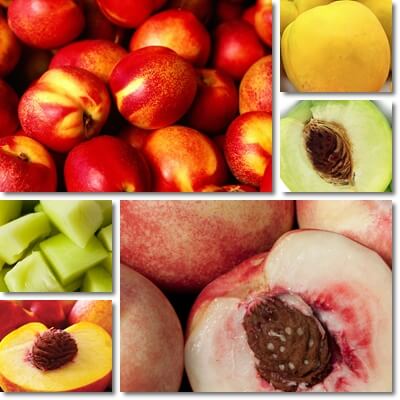Did you know that nectarines come in different colors, including red-purple, honeydew green and yellow? If you like eating nectarines, then you’ll love this simple guide to nectarines based on skin and flesh color, fruit shape and type of stone or pit to help you choose more easily among the dozens of different varieties available.
What are nectarines?
Nectarines are a peach-like fruit with sweet, juicy flesh and smooth, reddish skin. Botanically, nectarines are classified as a subspecies of peach. The first nectarine actually grew on a peach tree.
Nectarines occurred as a result of a spontaneous natural mutation that caused the gene that makes peaches fuzzy to become recessive and not manifest, resulting in a peach without fuzz. While very closely related to peaches, nectarines are treated as different fruit altogether.
Find out more about what is a nectarine.

Types of nectarines by color
1) Yellow nectarines or yellow-fleshed nectarines
Yellow nectarines, or yellow-fleshed nectarines to be more exact, are the most common type of nectarine. As you’d expect based on the name, yellow-fleshed nectarines have yellow flesh, most commonly golden yellow, although fruits with paler yellow flesh are also prevalent. Half the time, the flesh surrounding the pit or stone is also tinged with red or red-purple. The so-called yellow nectarines have a typical skin color: red tinged with yellow or greenish-white.
2) White nectarines or white-fleshed nectarines
White nectarines are a variety of nectarine with white flesh. This particular type of nectarine is just as sweet and flavorful as the yellow-fleshed nectarine, the only difference being the pale flesh color. Depending on cultivar, the skin may be red tinged with golden yellow or a pale whitish yellow, or yellow tinged with red.
3) Yellow mango nectarine
Mango nectarine is an interesting development in nectarine cultivation. The so-called mango nectarine is actually a type of nectarine with yellow skin and flesh.
While the flesh is typically a uniform golden yellow color at maturity, the skin may be entirely golden yellow, golden yellow with some yellow green, or predominantly yellow with reddish speckles, a red tinge or even an apricot blush.

4) Honeydew nectarine
As its more common name suggests, the honeydew nectarine is a type of nectarine that resembles a honeydew melon in color. Honeydew nectarines have a pale green or, in some cases, light yellowish-green skin, strongly reminiscent of the color of honeydew melon.
The flesh is pale, either a pale, whitish green or a very pale yellow. In some fruits, the flesh is visibly lighter in the center, usually whitish, and a pale green as it nears the skin.
5) Purple nectarines
Purple nectarines are nectarines with dark red or purple-red skin. The skin may be a uniform color, or lightly tinged or speckled with yellow or a greenish white.
This type of nectarine typically has a golden yellow flesh, although there are cultivars with pale yellow and white flesh, too. The flesh surrounding the pit can also be tinged with red or purple-red.
Types of nectarines by shape
1) Roundish nectarines
Most nectarines are rounded and somewhat heart-shaped, with a groove running across the fruit from the stem to the base.
The overall appearance is that of a peach, but without the fuzz.
2) Rectangular nectarines (flat nectarines)
Rectangular nectarines are more commonly known as flat nectarines and are the nectarine version of flat peaches.
The fruit are flattened at the top and bottom and look compressed, an atypical appearance for fruits. While unnatural looking, flat nectarines are quite popular, as are flat peaches and flat watermelons.
Types of nectarine by stone
1) Clingstone nectarines
Clingstones nectarines are nectarines whose flesh clings to the pit or stone in the center of the fruit (or whose pit or stone clings to the flesh).
These are a little bit more difficult to eat as the stone has an intricate design of ridges and groves which prevents the flesh that adheres to it from being consumed.
2) Freestone nectarines
Freestone nectarines are nectarines whose flesh is free from the pit or stone. That is, the flesh separates easily from the central pit or stone. This particular type if preferred because it makes consumption of the fruit easy.
3) Partially clingstone/freestone
There is another type of nectarine according to flesh adherence to the stone or pit and it’s called partially clingstone or partially freestone. When it comes to this particular type of nectarine, while the flesh does cling to the pit or stone in the center of the fruit, either it is not completely attached (only part of the flesh adheres to the pit/stone), or it does not adhere so strongly and pulls from the pit/stone.
